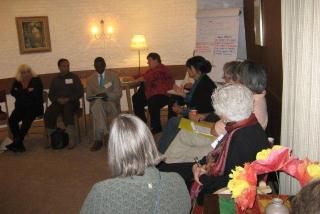WORKFORCE PREPARATION, TRAINING, AND SUPPORT–Theme group Summary

Here are some of their answers to the question, “Why should we dialogue with each other?”
- Economic crisis: not only hard-to-employ folks but also many skilled workers have lost jobs
- Jobs are going empty here in Tompkins County because people lack skills and training
- High school completion is a critical factor! The unemployment rate is 35-40% for young people without diplomas.
- Agencies such as TC Action, Workforce NY, get referrals from all over. But person-to-person dialogue like this can turn into a relationship/network that creates a circle of support for the worker, facilitates access and greater success. Some examples: Tompkins Community Action runs a weatherization program for low income households. Workers receive a living wage for weatherization jobs; also, training money is available to prepare workers for jobs in childcare and early childhood development (especially Headstart);Community Action in Elmira does a culinary training with a chef teaching participants to prepare food and work in food service jobs;TC Action is trying to support people to keep their jobs after stipends (subsidies that help employers to provide work and on-the-job training) run out, and workers wish to stay in those positions.
What to do?
- The pool of both jobs and participants in the commercial drivers license program dried up; classes were held during the day, which was a barrier for some folks; potential employers’ need for workers with CDL’s decreased. Could the training program by offered again, once a year? Or every other year?
- When employers have an initiative, it’s important to let the community know. (eg. Cayuga Med Ctr., and by people like ourselves knowing and watching that, we can let them know we noticed)
- Question the management if we notice that there aren’t people of color employed in local businesses; shoppers who notice should say something to the owner/manager. Let them know that you feel good about patronizing businesses that employ people of color.
- Start a movement where employers look beyond their personal networks to open up opportunities to others
- Question major institutions which have diversity goals but fail to follow them in their hiring practices.
More questions
- How do we increase access and equity in employment?
- How do we address the tendency (even when a candidate of color is qualified) to hire white folks because the employer is more comfortable with them?
- How will we gather data? how many people get hired, who are they? How much do they make? What are the demographics?
- How many rural and urban kids are not graduating? We see kids who have great grades in elementary school, but we lose them by middle school!
On the second day, this group asked themselves:
a) how they could be cost effective with the work that’s already being done and
b)what needs to change such as turf-issues as organizations compete for funding.
There is, as someone said, “a certain kind of exhaustion from ineffectiveness.”
One person called for a safe place where people can talk about injustices, another for transportation, and another, building on a growing theme in the overall workshop, for people to speak up when they see something that is not right.
A suggestion was to build collective group ownership and cooperatives.
Anticipating the case session in the afternoon, someone raised the Rebuilding the Wall project of Calvary Baptist, an effort to help hard to employ people find gainful employment..
Here are only a few of the habits they spoke of breaking and creating:
- get over turf issues between programs;
- stop stereotyping and operating from assumptions about the jobless,
- stop defining others’ circumstances–if different from ours–as “deficits;”
instead, we should:
- speak up,
- affirm all the ways people know what to do and how to manage money,
- mentor and support youth and hold the school districts accountable,
- extend our personal relationships beyond our habitual ones.
For more information – or to make corrections and additions (if you were in this group), please contact Laura Branca (laurabranca0@gmail.com)